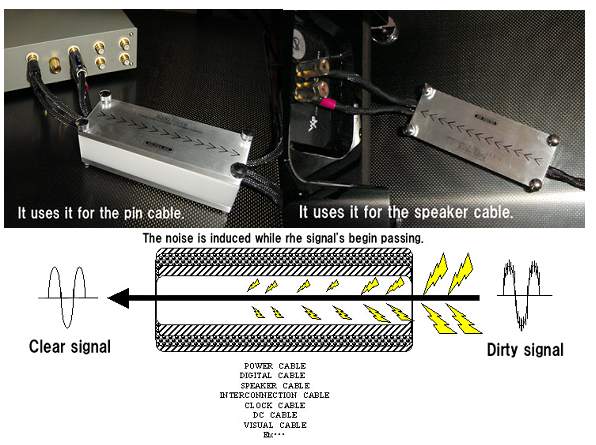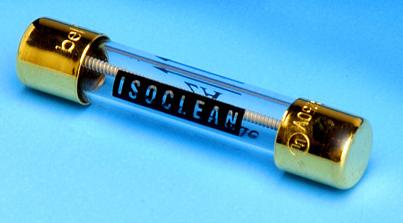Слышащий да услышит!
Цитата:
PRODUCT REVIEW: Listening
Up until now, my power cabling has consisted entirely of cords by David Elrod. At first, I used a full complement of EPS-2s and -3s. As much as I loved those cords, assurances from Jim Weil of Sound Applications and David himself that the EPS Signatures would provide far more body and bass heft led me to slowly replace all but one of my EPS -2 and 3s with EPS Signature 2s and 3s. Everything was ultimately powered by Signatures save for the Jadis amp, which was powered by an EPS-3.
I had grown quite satisfied with the Elrod cords. A recent decision to move my Talon Khorus X Mk. II speakers off their spikes and suspend them on the same Ganymede ball bearing supports I use under the rest of my equipment enabled me to decouple the speakers from the floor, resulting in far clearer bass. No longer dependent upon the width of my carpet to protect the hardwood floor from spike damage, I was able to separate my speakers by 12 feet. As a result, the soundstage widened, depth increased, everything became more realistic sounding. This led to even greater appreciation of the Elrod combination.
Then along came the two Valhallas. After they had broken in, I put one on my Jadis amp. I was initially confused by what I heard. While the bass was definitely substantial, everything sounded thicker and heavier than I wished it to sound. Was this the fault of the Valhalla, I wondered?
Further experimentation led to my discovery that the EPS Signatures, at least in my system, tend to increase body, midrange, and bass impact while simultaneously darkening the top. (I discovered the same effect with the AudioPrism SuperNatural S2 and many of the mostly discontinued Shunyata power snakes I’ve reviewed.) This never disturbed me before because the final Elrod cord in my chain, the EPS-3 on my amp, balanced out this darkening effect by lightening bass and adding clarity on top. This enabled me to hear a good deal of the heft of the Signatures without the darkness and heaviness that became apparent once the EPS-3 was replaced by a Nordost Valhalla.
It is essential to note that I have never heard the Elrod EPS Statement or S2 Statement II in my system. These huge $2700 power cables are in the same price range as the $2500 Valhallas and the only fair comparison with them. I did hear the EPS Statements in the Audio Aero/Joule/Joseph Audio room at CES 2004, and thought the sound one of the best at the show. The darkening effect of many cables in the $1500 range - the EPS Signatures are $1600 - may vanish with the $2700 EPS Statement. I encourage listeners to try the entire range of Elrod power cables, which I consider some of the best on the market.
What I needed to do was lighten things up. I tried the second Valhalla first on the Power Plant, then on my transport, last on the Theta Gen. VIII. In each position, it replaced an Elrod EPS Signature.
It was on the transport that the second Valhalla had the most impact. All of a sudden, I heard a level of deep bass, sparkling highs, three dimensionality, transparency, and air that I had never before heard on my system.
The change was anything but subtle. It was impossible to miss. The soundstage opened up, for the first time approaching the sense of boundlessness I experience in Davies Symphony Hall. There was an extra level of resonance, a greater awareness of the sound of the hall brought about by the Valhalla’s stunningly transparent window. (I can barely imagine how good this system will sound when the extra resolution promised by new digital formats becomes available to me via Theta’s anticipated DVD-A/SACD upgrade for the Theta Gen. VIII and Compli transport.)
I also experimented with adding two Vishnus to the mix. An hour or two of musical cables followed, as I jockeyed Valhallas and Vishnus back and forth between Power Plant, transport, Theta, and Jadis. My final conclusion is that the $600 Vishnu definitely shares with the Valhalla an extraordinary transparency and sparkling clarity that approach what I experience up close in live concert settings. What the Vishnu does not transmit is the sheer weight and bass extension of the Valhallas. For many audiophiles, combining one Valhalla on the transport or power conditioner with Vishnus on other components may deliver all the transparency, clarity, brilliance, and heft they desire.
While auditioning the phenomenal Parasound Halo JC 1 monoblocks, I put both Valhallas on the amps, my usual EPS Signature-3 on the Power Plant, and my usual EPS-Signature 2 on the Theta. On the transport, I variously tried the Vishnu ($600), the WireWorld Silver Electra 5 ($750), and the PS Audio X-treme Statement (variously listed for $400 and $500).
The WireWorld had the most bass heft of the three, and was quite transparent and alive on top. The Vishnu conveyed a shade less body and heft, but its highs (e.g., cymbals, piccolo, triangle) rang out with a three-dimensional vibrancy and additional degree of transparency that came much closer to the magic that I experience in live situations. With the Vishnu/Valhalla combo, sounds literally hang and glisten in space in a most thrilling way. The PS Audio conveyed the bass heft, but the top was darker than both the WireWorld Silver Electra 5 and the Nordost Vishnu, the window a bit clouded, and the presentation a bit murky. The sense of subtlety that I experience from both Nordost power cables was not to be had.
The $2500 Valhalla, of course, offers all the thrill, vibrancy, transparency, and subtlety of the $600 Vishnu as well as the size, weight, and bass heft of a $1600 EPS Signature. For audiophiles who want the ultimate in extension and musical involvement, the Valhalla is the way to go. Those who have heard the equivalent of Mahler’s Das Lied von der Erde from the center of Row H Orchestra of Davies Symphony Hall, or Mahler Symphony No. 2 from Row K Orchestra will especially appreciate what the Valhallas can do. They are, in a word, stunning.
http://www.hometheaterhifi.com/volume_11_3/nordost-vishnu-valhalla-power-cables-7-2004.html





 стоимостью около 100000 (сто тысяч) руб.
стоимостью около 100000 (сто тысяч) руб.
 и тому кто придёт в гости к владельцу подобного и тоже скажет что не слышит разницы
и тому кто придёт в гости к владельцу подобного и тоже скажет что не слышит разницы 







